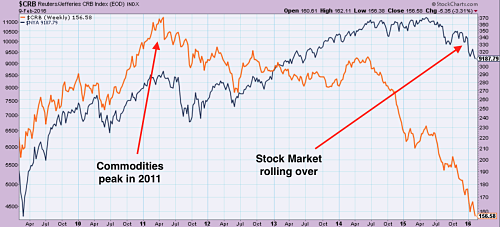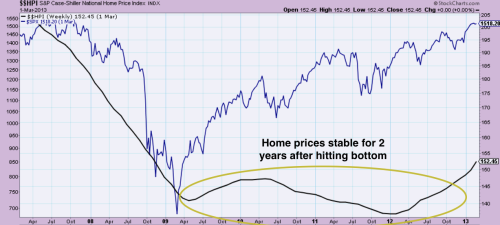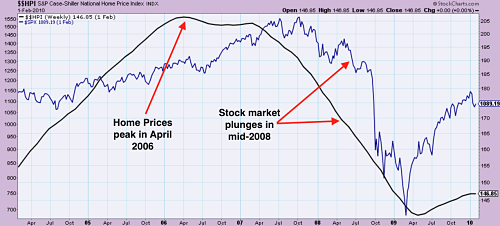Last week I watched “The Big Short.”
The movie portrays, really well, how unregulated capitalism set itself on fire less than a decade ago during the meltdown of the housing market. As I was watching it, my mind would link each of the events that preceded and followed the housing crash to the commodities crash we are living through today and, if history repeats itself, I could even picture what comes ahead.
The Bubble Shapes
All bubbles share similar characteristics. It all starts with strong demand for some object, whether it’s stocks, homes, commodities or tulips. In a very simplified way, the housing bubble started as banks gave loans to any individual, regardless of their income. As anyone could get a loan to pay for their home, housing prices started to pick up as demand increased. But higher prices weren’t a reflection of growth, they were just caused by easy money given out by banks.
In commodities, a bubble formed on hopes that China’s rapid growth would feed an ever-expanding appetite for raw materials. Moreover, in 2008 China launched a huge $586 billion economic stimulus plan, leading to higher demand for commodities and, therefore, rising prices. But prices weren’t reflecting real growth, either. They were inflated as fake demand was created on the construction of excessively extravagant government buildings and uninhabited “ghost cities” in China.
The Bubble Gets Bigger
During the housing bubble, everyone was making money. Banks were making interest money from their loans. House owners saw the value of their assets rise and everyone was pouring money into the housing market. Everything was built on hopes that housing couldn’t crash.
Similarly, everyone was making money as commodity prices rose. Huge infrastructure was built around the world to produce those commodities. Banks were making money on interest as producers took debt to build this new capacity. China was achieving its fake percentage growth rate and billions of dollars of capital investment were poured into commodities markets as an effective way to bet on China’s economic development. Everything was built on hopes that China would continue growing at that pace forever.
Prices Start Falling
Home prices (in black) peaked in 2006 while stock markets (in blue) sold-off two years later. Source: MetalMiner analysis of @StockCharts.com data.
House prices peaked in April 2006. Over the next couple of years, people believed that the decline in home prices was only a setback. That housing in the US was strong and prices could only continue to go higher. It wasn’t until 2008 until the market really acknowledged that both the home industry and banks were in big trouble.
As the housing sector collapsed and fears of banks going bankrupt piled up. The stock market started to roll over By mid-2008 home prices had declined considerably and it was then when stocks started to plunge.

Commodities peaked in 2011 (CRB Index – orange) and stocks are now rolling over (NYSE index – black). Source: MetalMiner analysis of @StockCharts.com data.
Similarly, commodity prices peaked in 2011. Over the next few years, things continued to be alright as people believed that there was nothing wrong with China and that commodity prices would soon go up. But the years went by and the fall in prices became more severe with oil prices plunging as well. The stock market is already rolling over and fears are starting to pile up.
Many commodity producers, especially in the energy sector, could go bankrupt. Banks are not getting paid on the money they have lent and commodity-producing countries are getting in serious trouble. Stock markets look now just as they looked like back in mid-2008: set up for a big trouble.
When the Bubble Burst
By the end of 2008, people had lost all their money invested in the housing market. As mortgages couldn’t be paid, banks took ownership of houses. The value of those houses was nothing compared to what they were selling for just a few years before.
The situation wasn’t sustainable anymore and people had to give in while some big banks declared bankruptcy. The collapse of housing and the financial sector drove stock markets to the floor. Once things had collapsed, stock markets hit bottom and home prices started to stabilize.
Similarly, the situation among producers is not sustainable anymore. Some of them just can’t remain loss-making enterprises forever. Shutdowns need to occur. The situation hurts producers but the banks that lent the money to build new capacity created financial instability, as well. That could trigger further sell-offs in the stock market.
When Markets Hit Bottom

After stock markets (in blue) hit bottom in 2009, home prices (in black) were stable for 2 more years before turning back upward. Source: MetalMiner analysis of @StockCharts.com data.
Once markets hit bottom, supply and demand finally started to come back into balance again. But it took another couple of years to remove the excess of stock (empty houses) and let new demand catch up. Similarly, low commodity prices will result in loan defaults and bankruptcies by commodity producers, weakening financial institutions. Then, the stock market will finally hit bottom letting other industry sectors drive up the economy.
Only then will commodities markets start to rebalance but it will take some time to clean up the excess stock (material) and let new demand catch up. If history is to repeat itself, commodity pries will continue to decline until global markets hit bottom and, then, we will see an extended period of commodity price stabilization before prices start to move upwards, unless of course, another China comes with a new set of stimulus measures and creates a new bubble.

